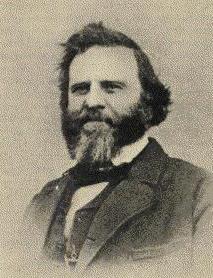Frederick P. Stanton
Frederick P. Stanton | |
|---|---|
 | |
| Acting GovernorofKansas Territory | |
| In office April 15, 1857 – May 27, 1857 | |
| Preceded by | Daniel Woodson(Acting) |
| Succeeded by | Robert J. Walker |
| In office November 16, 1857 – December 21, 1857 | |
| Preceded by | James W. Denver |
| Succeeded by | Samuel Medary |
| Secretary of Kansas Territory | |
| In office April 1, 1857 – December 21, 1857 | |
| Preceded by | Daniel Woodson |
| Succeeded by | James W. Denver |
| Chair of theHouse Judiciary Committee | |
| In office March 4, 1853 – March 4, 1855 | |
| Preceded by | James X. McLanahan |
| Succeeded by | George A. Simmons |
| Member of theUnited States House of RepresentativesfromTennessee's10thdistrict | |
| In office March 4, 1845 – March 4, 1855 | |
| Preceded by | John B. Ashe |
| Succeeded by | Thomas Rivers |
| Chair of theHouse Naval Affairs Committee | |
| In office March 4, 1849 – March 4, 1853 | |
| Preceded by | Thomas Butler King |
| Succeeded by | Thomas S. Bocock |
| Personal details | |
| Born | Frederick Perry Stanton December 22, 1814 Alexandria,District of Columbia |
| Died | June 4, 1894(aged 79) Florida |
| Political party | Democratic(until 1861) Republican(after 1861) |
| Parent(s) | Richard Stanton Harriet Perry |
| Education | George Washington University |
Frederick Perry Stanton(December 22, 1814 – June 4, 1894) was an American lawyer and politician who served in theUnited States House of RepresentativesforTennessee's10th congressional districtand as Secretary (and at times acting governor) of theKansas Territory.
Early life and career[edit]
Stanton was born inAlexandria,District of Columbia(now Virginia) on Dec. 22, 1814, son of Richard and Harriet Perry Stanton and brother ofRichard H. Stanton.His father Richard was a soldier in theAmerican Revolutionary War,and afterwards became a bricklayer (a skill that he later taught his son). His elder brotherRichard Henry Stanton(1812-1891) would move to Kentucky and also became a U.S. Congressman, serving from 1849 until 1855, and later becoming a state judge. His younger brother Thomas Stanton (1825-1900) would move to Michigan. The family also included brothers John and Richard and four sister, one of whom Jane Perry Gookin, would move to Tennessee with her children and their mother to live with this brother and his family.
Education[edit]
Stanton was taught at an early age by the Quaker teacherBenjamin Hallowell.Stanton subsequently attendedColumbian Universityto study classical studies, and he graduated in 1833 at age 19.
Teaching and law careers[edit]
After graduating, Stanton taught for a while inVirginia,then at a college inNorth Carolina.At the time, he prepared to enter aBaptistministry, but instead focused on law.
In 1834, Stanton was admitted to theTennesseebar and opened a law office inMemphis.
Career[edit]
House of Representatives[edit]
Elected as aDemocratto theTwenty-ninth Congressand the four succeeding Congresses, Stanton served from March 4, 1845 to March 3, 1855.[1]After winning his first election, his chagrined Whig opponent shot Stanton in the neck with a pistol. During theThirty-firstandThirty-second Congresses,he was chairman of theCommittee on Naval Affairs,and during theThirty-third Congresshe was chairman of theCommittee on the Judiciary.[2]
Years in Kansas[edit]
Stanton served as the governor ofKansas Territoryfrom 1858 to 1861, according to theBiographical Directory of the United States Congress.However, according to theLecomptonHistorical Society, he instead served as acting governor from April 15, 1857 to May 27, 1857 and from November 16, 1857 to December 21, 1857. On April 1 of that year, he had been appointed Secretary of Kansas Territory, and he held that office until December 21. He was twice proposed as a United States Senator, the first time in 1859 contingent upon the admission of Kansas under theLecompton Constitution,the second in 1861 when incumbent senatorJames H. Lanewas offered a commission in the United States Army, but both times no such opportunity materialized.[3]
Later life[edit]
At the beginning of theCivil WarStanton joined theRepublican Party.In 1861 he opened alaw officein Washington, D. C., for practice in the Supreme Court of the United States. In his later years Stanton was active in efforts for world peace. He was president of the International Peace League, and was a delegate to the Richmond convention in 1882. He was also president of theNational Arbitration League of America,and opened its inaugural convention in Washington in 1882.[4]Three years later, Stanton moved to Florida for his health, and resided in that state until his death.[5]
Death and legacy[edit]
Stanton died near Ocala, Marion County, Florida on June 4, 1894 (age 79 years, 164 days). He isinterredat South Lake Weir Cemetery at South Lake Weir, Florida.[6]A marble bust of Gov. Stanton is among the collections of the Kansas Historical Society.
References[edit]
- ^"Frederick Perry Stanton".Govtrack US Congress.Retrieved14 March2013.
- ^"Frederick Perry Stanton".Biographical Directory of the United States Congress.Retrieved14 March2013.
- ^Kansas: A cyclopedia of state history, embracing events, institutions, industries, counties, cities, towns, prominent persons, etc.... / with a supplementary volume devoted to selected personal history and reminiscence,ed. by Frank W. Blackmar. Standard Pub. Co., Chicago: 1912., Vol. II: 751.
- ^New York Times,May 31, 1882, p. 1
- ^"Frederick Perry Stanton".State Library of Kansas.Archived fromthe originalon November 10, 2012.Retrieved14 March2013.
- ^"Frederick Perry Stanton".The Political Graveyard.Retrieved14 March2013.
External links[edit]
- Lecompton, Kansas' list of acting governors of Kansas TerritoryArchived2006-07-12 at theWayback Machine
- Kansas: a cyclopedia of state history, embracing events, institutions, industries, counties, cities, towns, prominent persons, etc.
- United States Congress."Frederick P. Stanton (id: S000802)".Biographical Directory of the United States Congress.


